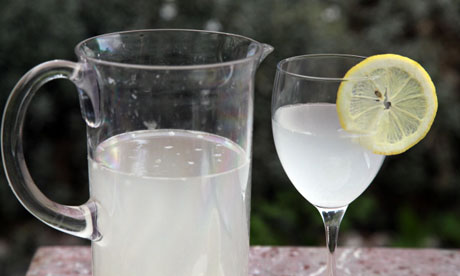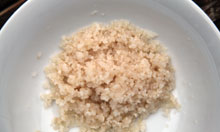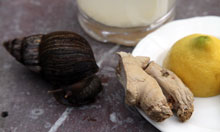How to make real ginger beer (2011 plan)
Unlike anything you'll find in the shops, real ginger beer is made by a symbiotic pair of micro-organisms

Real ginger beer. Photograph: John Wright
For reasons known only to herself my daughter keeps giant African land snails as pets. They do nothing except eat, get bigger and produce offspring at a rate sufficient to supply the entire country, should the country want them. Unfortunately you can't even give the blasted things away and a distressing culling regime has had to be introduced (and, no, I am not going to do this).
I have been here before. Years ago I would frequently be offered "ginger beer plants" (GBP) by hollow-eyed owners, desperate to find new homes for a burgeoning population. Having once suffered the guilt-ridden burden of responsibility these "pets" entail, I would invariably refuse. Unfortunately I was not alone in my refusal. The GBP has now suffered a sad decline and can be difficult to find these days.
But what is a GBP? Simply put, it is a jelly-like substance used to make a mildly alcoholic ginger beer. What it emphatically is not, is a plant. Its true nature was discovered by an impressively moustachioed nineteenth century naturalist called Harry Marshall Ward. After prolonged and commendably systematic study he discovered it to be a mixture of yeasts and bacteria – about 20 species altogether. However, only two of the constituents were essential in the making of a good brew – one was a yeast and one a bacterium.
 Ginger beer plant, or GBP. Photograph: John Wright The yeast was Saccharomyces pyriformis (meaning pear shaped sugar fungus) and the bacterium was Brevibacterium vermiforme (oxymoronically - short bacteria shaped like a worm). The bacteria form a jellified mesh in which the yeast cells reside. But they were not just cohabiting – they formed a symbiotic relationship as do fungi and algae to form lichens. The yeast excrete alcohol and the bacterium consume it, allowing the yeast, which can tolerate only low alcohol concentrations, to continue to thrive. Several other such relationships exist, notably "kefir" which has long been used to ferment milk.
Ginger beer plant, or GBP. Photograph: John Wright The yeast was Saccharomyces pyriformis (meaning pear shaped sugar fungus) and the bacterium was Brevibacterium vermiforme (oxymoronically - short bacteria shaped like a worm). The bacteria form a jellified mesh in which the yeast cells reside. But they were not just cohabiting – they formed a symbiotic relationship as do fungi and algae to form lichens. The yeast excrete alcohol and the bacterium consume it, allowing the yeast, which can tolerate only low alcohol concentrations, to continue to thrive. Several other such relationships exist, notably "kefir" which has long been used to ferment milk.
The ginger beer produced by the GBP is "real" ginger beer, having a subtlety of flavour mostly lacking in one made from ordinary yeast and entirely lacking in the non-alcoholic stuff you buy in the shops. Flavours are difficult to describe and I can only suggest "creamy toffee" to give you an idea.
Like many homebrews it is fascinating to watch the fermentation process. The little jelly "crystals", buoyed by CO2 float up and down in the jug to lava lamp effect, albeit it a rather murky one. You will end up with more GBP than you started with and this is where your problems begin – what to do with this exotic living organism that looks to you for love and attention. Well I am sure you will be able to give some away, but mostly you should keep it so you can make more and more ginger beer. After all you are going to need lashings of it.
I am grateful to my friend and GBP guru, Tim, for reintroducing me to this strange organism.
 Ginger beer ingredients (and a giant snail). Photograph: John Wright Ginger beer plant - about a tablespoonful. Remember that you cannot make this from ordinary yeast – you have to find one. They are sometimes available online.
Ginger beer ingredients (and a giant snail). Photograph: John Wright Ginger beer plant - about a tablespoonful. Remember that you cannot make this from ordinary yeast – you have to find one. They are sometimes available online.
250g sugar
2 litres water (should be chlorine free – a large pinch of ascorbic acid (vitamin C), or the juice of a lemon will remove the chlorine if you are unsure)
½ teaspoon cream of tartar (this stabilises the acid level but is not essential)
Juice of 1 lemon
2 or 3 inches of ginger, peeled and grated (dried ginger powder is an alternative)
The GBP is a pretty resilient creature but it is safest to make sure everything is clean in the kitchen. Tie the grated ginger in a small piece of muslin. Place it (or dried ginger) with the sugar, lemon juice, cream of tartar and water in a large jug. Stir until the sugar has dissolved. Add the GBP. Cover with a cloth fixed in place with an elastic band, or just a lid if there is one.
Leave for about five days (or until it tastes just a little sweeter than you would like the finished product to be) then carefully pour into plastic pop bottles or swing top bottles using a fine sieve and a funnel. (You will find a larger GBP in the sieve than you started with. Remove the muslin then rinse the GBP in fresh water. Use it to make another batch). It is ready to drink within two or three days, though a week is fizzier. The low activity of the yeast and small amount of sugar used will ensure that explosive levels of CO2 are not reached, but it may be worth checking a test bottle every now and then by loosening the lid just to make sure. Chilling in the fridge will stop any further fermentation if you are happy with the level of fizz and sweetness.
I have been here before. Years ago I would frequently be offered "ginger beer plants" (GBP) by hollow-eyed owners, desperate to find new homes for a burgeoning population. Having once suffered the guilt-ridden burden of responsibility these "pets" entail, I would invariably refuse. Unfortunately I was not alone in my refusal. The GBP has now suffered a sad decline and can be difficult to find these days.
But what is a GBP? Simply put, it is a jelly-like substance used to make a mildly alcoholic ginger beer. What it emphatically is not, is a plant. Its true nature was discovered by an impressively moustachioed nineteenth century naturalist called Harry Marshall Ward. After prolonged and commendably systematic study he discovered it to be a mixture of yeasts and bacteria – about 20 species altogether. However, only two of the constituents were essential in the making of a good brew – one was a yeast and one a bacterium.
 Ginger beer plant, or GBP. Photograph: John Wright The yeast was Saccharomyces pyriformis (meaning pear shaped sugar fungus) and the bacterium was Brevibacterium vermiforme (oxymoronically - short bacteria shaped like a worm). The bacteria form a jellified mesh in which the yeast cells reside. But they were not just cohabiting – they formed a symbiotic relationship as do fungi and algae to form lichens. The yeast excrete alcohol and the bacterium consume it, allowing the yeast, which can tolerate only low alcohol concentrations, to continue to thrive. Several other such relationships exist, notably "kefir" which has long been used to ferment milk.
Ginger beer plant, or GBP. Photograph: John Wright The yeast was Saccharomyces pyriformis (meaning pear shaped sugar fungus) and the bacterium was Brevibacterium vermiforme (oxymoronically - short bacteria shaped like a worm). The bacteria form a jellified mesh in which the yeast cells reside. But they were not just cohabiting – they formed a symbiotic relationship as do fungi and algae to form lichens. The yeast excrete alcohol and the bacterium consume it, allowing the yeast, which can tolerate only low alcohol concentrations, to continue to thrive. Several other such relationships exist, notably "kefir" which has long been used to ferment milk.The ginger beer produced by the GBP is "real" ginger beer, having a subtlety of flavour mostly lacking in one made from ordinary yeast and entirely lacking in the non-alcoholic stuff you buy in the shops. Flavours are difficult to describe and I can only suggest "creamy toffee" to give you an idea.
Like many homebrews it is fascinating to watch the fermentation process. The little jelly "crystals", buoyed by CO2 float up and down in the jug to lava lamp effect, albeit it a rather murky one. You will end up with more GBP than you started with and this is where your problems begin – what to do with this exotic living organism that looks to you for love and attention. Well I am sure you will be able to give some away, but mostly you should keep it so you can make more and more ginger beer. After all you are going to need lashings of it.
I am grateful to my friend and GBP guru, Tim, for reintroducing me to this strange organism.
Real ginger beer
 Ginger beer ingredients (and a giant snail). Photograph: John Wright Ginger beer plant - about a tablespoonful. Remember that you cannot make this from ordinary yeast – you have to find one. They are sometimes available online.
Ginger beer ingredients (and a giant snail). Photograph: John Wright Ginger beer plant - about a tablespoonful. Remember that you cannot make this from ordinary yeast – you have to find one. They are sometimes available online.250g sugar
2 litres water (should be chlorine free – a large pinch of ascorbic acid (vitamin C), or the juice of a lemon will remove the chlorine if you are unsure)
½ teaspoon cream of tartar (this stabilises the acid level but is not essential)
Juice of 1 lemon
2 or 3 inches of ginger, peeled and grated (dried ginger powder is an alternative)
The GBP is a pretty resilient creature but it is safest to make sure everything is clean in the kitchen. Tie the grated ginger in a small piece of muslin. Place it (or dried ginger) with the sugar, lemon juice, cream of tartar and water in a large jug. Stir until the sugar has dissolved. Add the GBP. Cover with a cloth fixed in place with an elastic band, or just a lid if there is one.
Leave for about five days (or until it tastes just a little sweeter than you would like the finished product to be) then carefully pour into plastic pop bottles or swing top bottles using a fine sieve and a funnel. (You will find a larger GBP in the sieve than you started with. Remove the muslin then rinse the GBP in fresh water. Use it to make another batch). It is ready to drink within two or three days, though a week is fizzier. The low activity of the yeast and small amount of sugar used will ensure that explosive levels of CO2 are not reached, but it may be worth checking a test bottle every now and then by loosening the lid just to make sure. Chilling in the fridge will stop any further fermentation if you are happy with the level of fizz and sweetness.
Discover with us the secrets of fitness and body-building
ردحذفhttp://secrets-fitness.blogspot.com
اخبارية العويقيلة
ردحذفاخبارية العويقيلة
اخبارية العويقيلة
اخبارية العويقيلة
اخبارية العويقيلة
اخبارية العويقيلة
اخبارية العويقيلة